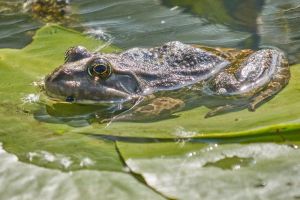Amphibians

Amphibians (Amphibia), formerly known as batrachians , are a class of tetrapod vertebrates. They are generally defined as a group including " all non-amniote tetrapods ". The branch of zoology that studies them (and the " reptiles ") is herpetology, or more precisely batrachology, from the Greek batrachos, frog, which is specifically devoted to them.
Amphibians live in a wide variety of habitats, but most species prefer terrestrial, freshwater or arboreal ecosystems. Amphibians generally start life as aquatic larvae, which later metamorphose into their final adult form, but some species do not undergo this metamorphosis, either remaining larval throughout their lives and reproducing as such (neoteny), or taking on a miniature adult form before hatching. The larva has a totally aquatic lifestyle and breathes through gills, whereas the adult has lungs and breathes in the open air. Amphibians use their skin as a secondary respiratory surface, and some species of small salamanders and terrestrial frogs even breathe exclusively through their skin, and have no lungs. They have a number of similarities with reptiles, but reptiles are amniotes which, like birds and mammals, do not need water to reproduce. Amphibians need chemically unpolluted water for their reproduction and the health of their permeable skin, making them good ecological indicators. In recent decades, there has been a spectacular decline in their populations around the world, due to pollution and the spread of fungal infections.
The first amphibians appeared at the beginning of the Devonian period among the sarcopterygian " fish ", equipped with lungs and bony fins, organs adapted to regular and prolonged flooding on the foreshores of estuaries, deltas and other paralic environments. They diversified and became the predominant group of terrestrial vertebrates during the Carboniferous and early Permian periods, before being supplanted by the amniotes, whose rise benefited from the disappearance of numerous amphibian lineages in the course of mass extinctions. Only the smaller and less diverse ancestors of the subclass Lissamphibians have survived to the present day.
The three modern orders of amphibians are the anurans(frogs and toads), the urodeles(newts and salamanders) and the gymnophiones (cecilias). The total number of known amphibian species is around 7,000, of which almost 90 % are frogs (compare with mammals : around 5,000 species). The world's smallest amphibian (and smallest terrestrial vertebrate) is a New Guinea frog, Paedophryne amauensis, which measures just 7.7 mm. The largest living amphibian is the Chinese Giant Salamander (Andrias davidianus) at 1.8 m long, but this is still well short of the 9 m of Prionosuchus, an extinct species that lived during the Permian in Brazil, or the 7 m of the Alweynskop Brachyopoid in Lesotho, which lived at the end of the Triassic and beginning of the Jurassic.
According to the International Union for Conservation of Nature (IUCN) red list published in 2019, 40 % of the 8,100 amphibian species listed are in danger of extinction.()